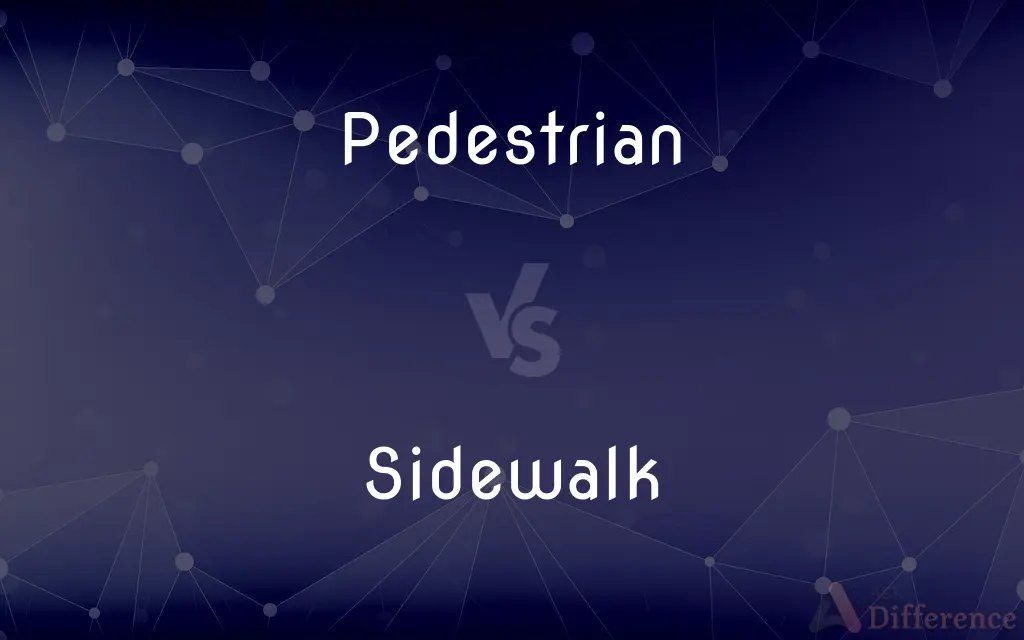Pedestrian vs. Sidewalk — What's the Difference?
By Maham Liaqat & Urooj Arif — Updated on March 20, 2024
A pedestrian is a person walking, especially in an area designated for foot traffic, while a sidewalk is a paved path alongside a street for pedestrian use.

Difference Between Pedestrian and Sidewalk
Table of Contents
ADVERTISEMENT
Key Differences
Pedestrians are individuals who travel on foot, whether walking, running, or moving with the aid of mobility devices like wheelchairs. They are a key component of urban and suburban environments, navigating through spaces specifically designed for foot traffic, such as sidewalks, crosswalks, and pedestrian zones. On the other hand, a sidewalk is a structural element of urban planning, a paved pathway bordering streets, providing a safe area for pedestrians to walk separate from motorized traffic. Sidewalks are constructed to enhance pedestrian safety, accessibility, and convenience, often featuring ramps, lighting, and sometimes benches or greenery.
While pedestrians represent the human element of foot traffic, moving dynamically and interacting with their surroundings, sidewalks are static, physical infrastructures designed to accommodate and protect pedestrians in built environments. Pedestrians use sidewalks as their primary routes for walking in cities and towns, underscoring the relationship between the mobility needs of individuals and the provision of safe, accessible walking environments. Conversely, the design and maintenance of sidewalks directly impact the safety and comfort of pedestrians, with well-designed sidewalks encouraging walking as a mode of transport.
Pedestrians may navigate various environments beyond sidewalks, such as trails, parks, or pedestrian-only zones in city centers, indicating the broad scope of pedestrian activity. Sidewalks, however, are specifically located in urban or suburban settings, paralleling streets to form a network that connects different parts of a community. This distinction highlights the varied contexts in which pedestrians operate and the focused role of sidewalks in urban pedestrian infrastructure.
The interaction between pedestrians and sidewalks is governed by regulations and norms that ensure safety and accessibility. Pedestrians are expected to follow certain rules, such as using crosswalks and obeying pedestrian signals, while sidewalks are subject to design standards and maintenance requirements to remain safe and navigable. This mutual dependence illustrates the critical role of both pedestrians and sidewalks in creating functional, livable urban environments.
Pedestrians and sidewalks are interdependent, with pedestrians relying on sidewalks for safe passage through urban areas, and sidewalks existing to serve the needs of pedestrians. The effectiveness of this relationship is essential for promoting walking as a sustainable and healthy form of transportation, highlighting the importance of both in urban planning and public health.
ADVERTISEMENT
Comparison Chart
Definition
A person walking in an urban or suburban area.
A paved path designed for pedestrian use alongside a street.
Primary Function
To navigate and move through spaces on foot.
To provide a safe, designated area for pedestrians to walk.
Environment
Can be found in urban, suburban, parks, and trails.
Primarily located in urban and suburban areas alongside roads.
Interaction with Traffic
Interacts with traffic at crosswalks and intersections.
Designed to separate pedestrian from vehicular traffic.
Maintenance and Design
Subject to rules and regulations for safety.
Requires regular maintenance and adherence to design standards for accessibility and safety.
Compare with Definitions
Pedestrian
Includes people using mobility aids.
Pedestrians with wheelchairs navigate sidewalks and crosswalks.
Sidewalk
Often features lighting and benches.
The well-lit sidewalk is safe for evening walks.
Pedestrian
An individual walking in a city or town.
Pedestrians must wait for the walk signal before crossing the street.
Sidewalk
Requires maintenance to stay safe.
The community reported the cracked sidewalk for repair.
Pedestrian
Subject to traffic laws when crossing streets.
Pedestrians crossing against the signal may be fined.
Sidewalk
Separates pedestrians from vehicular traffic.
The wide sidewalk ensures a safe distance from the road.
Pedestrian
Interacts with urban infrastructure.
Pedestrians use sidewalks, pedestrian bridges, and tunnels.
Sidewalk
A paved path for walking alongside a road.
The city added a new sidewalk to improve pedestrian safety.
Pedestrian
May walk for leisure, exercise, or commuting.
The park was full of pedestrians enjoying the sunny day.
Sidewalk
Designed to be accessible for all pedestrians.
The new sidewalks feature ramps for wheelchair access.
Pedestrian
A pedestrian is a person travelling on foot, whether walking or running. In modern times, the term usually refers to someone walking on a road or pavement, but this was not the case historically.The meaning of pedestrian is displayed with the morphemes ped- ('foot') and -ian ('characteristic of').
Sidewalk
A sidewalk (North American English), pavement (British English), footpath (Oceanian English), or footway, is a path along the side of a road. Usually constructed of concrete or asphalt, it is designed for pedestrians.
Pedestrian
A person traveling on foot; a walker.
Sidewalk
A paved walkway along the side of a street.
Pedestrian
Of, relating to, or made for pedestrians
A pedestrian bridge.
Sidewalk
(US) (usually) a paved footpath located at the side of a road, for the use of pedestrians
Pedestrian
Going or performed on foot
A pedestrian journey.
Sidewalk
Any paved footpath, even if not located at the side of a road
Pedestrian
Undistinguished; ordinary
Pedestrian prose.
Sidewalk
A walk for foot passengers at the side of a street or road; a foot pavement.
Pedestrian
(not comparable) Of or intended for those who are walking.
Pedestrian crossing
Pedestrian zone
Sidewalk
Walk consisting of a paved area for pedestrians; usually beside a street or roadway
Pedestrian
Ordinary, dull; everyday; unexceptional.
His manner of dress was pedestrian but tidy.
A pedestrian life
Pedestrian
(dance) Pertaining to ordinary, everyday movements incorporated in postmodern dance.
The choreographer prefers pedestrian movements.
Pedestrian
A walker; one who walks or goes on foot, especially as opposed to one who uses a vehicle.
Pedestrian
(dated) An expert or professional walker or runner; one who performs feats of walking or running.
Pedestrian
Going on foot; performed on foot; as, a pedestrian journey.
Pedestrian
Lacking in distinction or imaginativeness; ordinary; commonplace; dull; insipid; prosaic; as, pedestrian prose.
Pedestrian
A walker; one who journeys on foot; a foot traveler; specif., a professional walker or runner.
Pedestrian
A person who travels by foot
Pedestrian
Lacking wit or imagination;
A pedestrian movie plot
Common Curiosities
Why is it important for pedestrians to follow traffic signals?
Following traffic signals ensures pedestrian safety by reducing the risk of accidents at intersections and crosswalks.
What is the purpose of a sidewalk?
Sidewalks provide a safe and designated area for pedestrians to walk, separate from vehicular traffic.
Can cyclists use sidewalks?
Regulations on cyclists using sidewalks vary by location; some areas allow it, while others restrict sidewalk use to pedestrians only.
Who is responsible for sidewalk maintenance?
Sidewalk maintenance is typically the responsibility of local government or property owners, depending on local laws.
How do pedestrians safely cross streets?
Pedestrians should cross streets at marked crosswalks or intersections, following pedestrian signals where available.
How do sidewalks contribute to urban mobility?
Sidewalks enable safe and efficient pedestrian movement, contributing to the overall mobility and livability of urban areas.
What happens if a sidewalk is in disrepair?
Sidewalks in disrepair can pose hazards to pedestrians and may lead to accidents or reduced accessibility.
What makes a sidewalk accessible?
Accessible sidewalks have features like ramps, tactile paving, and sufficient width to accommodate wheelchairs and mobility devices.
Can pedestrians walk on the road if there is no sidewalk?
When no sidewalk is available, pedestrians may walk on the edge of the road, facing oncoming traffic, where it is safe to do so.
What is the difference between a sidewalk and a footpath?
Sidewalks are specifically alongside urban roads, while footpaths can be in rural or natural settings, not always adjacent to roads.
How do urban planners ensure sidewalks meet community needs?
Urban planners involve community input, consider pedestrian traffic volumes, and adhere to accessibility standards in sidewalk design.
Why are sidewalks important for public health?
Sidewalks encourage walking, which benefits physical health, and contribute to a community's social and mental well-being.
What are pedestrian zones?
Pedestrian zones are areas designated exclusively for pedestrian use, often found in city centers or shopping districts.
How do weather conditions affect sidewalk safety?
Adverse weather, such as snow, ice, or heavy rain, can reduce sidewalk safety, necessitating prompt maintenance and cleaning.
Can the absence of sidewalks deter pedestrian activity?
Yes, the absence of sidewalks can make walking unsafe or unpleasant, deterring people from walking for transportation or recreation.
Share Your Discovery

Previous Comparison
Deny vs. Reject
Next Comparison
Nucleus vs. NucleolusAuthor Spotlight
Written by
Maham LiaqatCo-written by
Urooj ArifUrooj is a skilled content writer at Ask Difference, known for her exceptional ability to simplify complex topics into engaging and informative content. With a passion for research and a flair for clear, concise writing, she consistently delivers articles that resonate with our diverse audience.















































